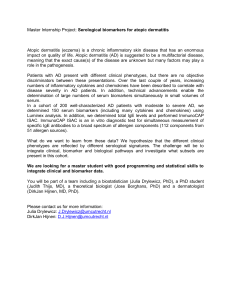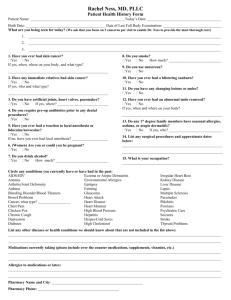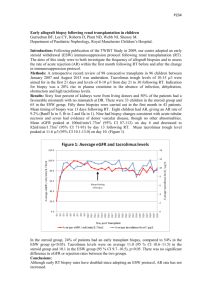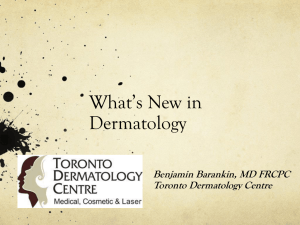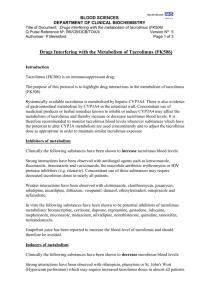Abstract
advertisement
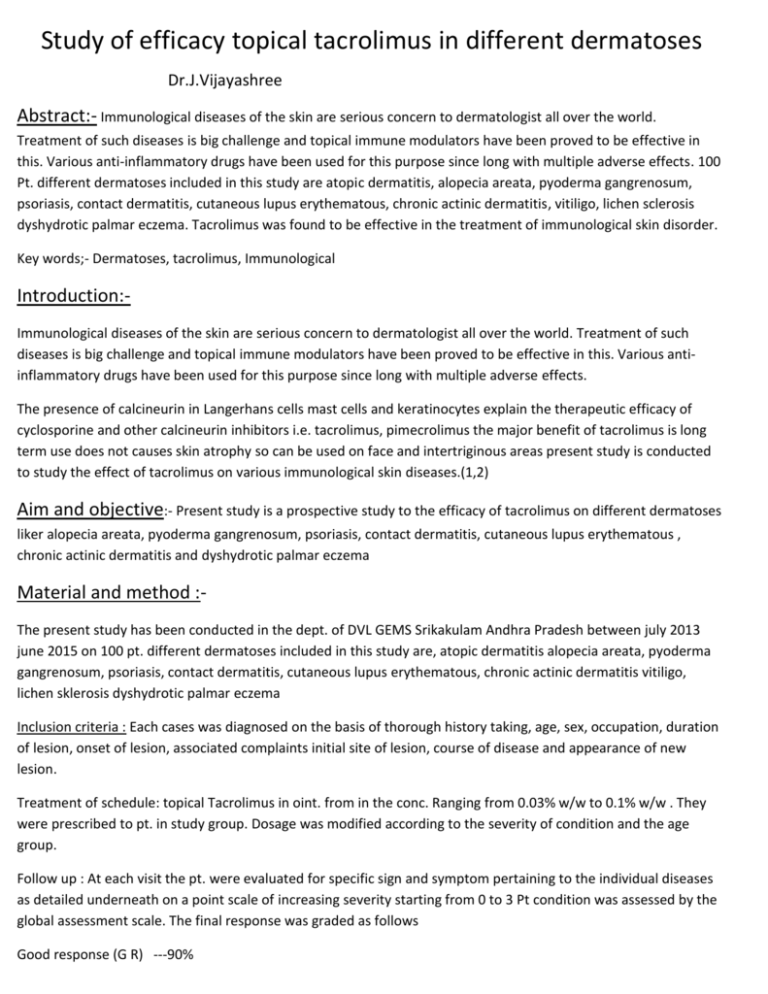
Study of efficacy topical tacrolimus in different dermatoses Dr.J.Vijayashree Abstract:- Immunological diseases of the skin are serious concern to dermatologist all over the world. Treatment of such diseases is big challenge and topical immune modulators have been proved to be effective in this. Various anti-inflammatory drugs have been used for this purpose since long with multiple adverse effects. 100 Pt. different dermatoses included in this study are atopic dermatitis, alopecia areata, pyoderma gangrenosum, psoriasis, contact dermatitis, cutaneous lupus erythematous, chronic actinic dermatitis, vitiligo, lichen sclerosis dyshydrotic palmar eczema. Tacrolimus was found to be effective in the treatment of immunological skin disorder. Key words;- Dermatoses, tacrolimus, Immunological Introduction:Immunological diseases of the skin are serious concern to dermatologist all over the world. Treatment of such diseases is big challenge and topical immune modulators have been proved to be effective in this. Various antiinflammatory drugs have been used for this purpose since long with multiple adverse effects. The presence of calcineurin in Langerhans cells mast cells and keratinocytes explain the therapeutic efficacy of cyclosporine and other calcineurin inhibitors i.e. tacrolimus, pimecrolimus the major benefit of tacrolimus is long term use does not causes skin atrophy so can be used on face and intertriginous areas present study is conducted to study the effect of tacrolimus on various immunological skin diseases.(1,2) Aim and objective:- Present study is a prospective study to the efficacy of tacrolimus on different dermatoses liker alopecia areata, pyoderma gangrenosum, psoriasis, contact dermatitis, cutaneous lupus erythematous , chronic actinic dermatitis and dyshydrotic palmar eczema Material and method :The present study has been conducted in the dept. of DVL GEMS Srikakulam Andhra Pradesh between july 2013 june 2015 on 100 pt. different dermatoses included in this study are, atopic dermatitis alopecia areata, pyoderma gangrenosum, psoriasis, contact dermatitis, cutaneous lupus erythematous, chronic actinic dermatitis vitiligo, lichen sklerosis dyshydrotic palmar eczema Inclusion criteria : Each cases was diagnosed on the basis of thorough history taking, age, sex, occupation, duration of lesion, onset of lesion, associated complaints initial site of lesion, course of disease and appearance of new lesion. Treatment of schedule: topical Tacrolimus in oint. from in the conc. Ranging from 0.03% w/w to 0.1% w/w . They were prescribed to pt. in study group. Dosage was modified according to the severity of condition and the age group. Follow up : At each visit the pt. were evaluated for specific sign and symptom pertaining to the individual diseases as detailed underneath on a point scale of increasing severity starting from 0 to 3 Pt condition was assessed by the global assessment scale. The final response was graded as follows Good response (G R) ---90% Partial response (P R) ---- 30 – 69% No response (NR) ---- < 30% 1. Atopic dermatic : scale of 0-3, for the severity of erythma, oozing, or crusting, excoriation and lichenification of involved skin, and dryness of non- involved skin 2. Alopecia areata : Assessed by GR, PR and NR 3. Pyoderma gangrenosum : healing of ulcer 4. Psoriasis: assessed by erythema, infiltration and desquamation 5. Contact dermatitis : assessed by erythema, oozing, papules, vehicles, pustules, pruritus 6. Discoid lupus erythematous: patient were assessed for erythema scaling and flattering of lesions 7. Chronic actinic dermatitis: pt. were assessed for erythema, scaling, pigmentation, thickening of skin and pruritus 8. Vitiligo : follicular and total repigmentation of the lesion 9. Lichen sclerosis : pruritus and remission of lesion 10. Dyshydrotic palmar eczema : pruritus and clearance of lesion Result:- Out of 100 pt. 30% were from high income group, 60% middle income group and 10% were low income group Table:-1Group wise disease, Age & Sex Distribution in 100 Patients under study S.NO Disease Total Pts in Dis. Sub. Gr. 0-10 11-20 21-30 31-40 M M F M F M F 41-50 F M F 1 Atopic dermatitis 25 7 8 4 3 0 0 0 3 0 0 2 Alopecia areata 18 3 3 4 2 0 0 5 1 0 0 3 Pyoderma Gangrenosum 5 2 0 0 0 0 0 0 3 0 0 4 Psoriasis 10 0 0 0 0 2 1 4 2 1 0 5 Contact dermatitis 10 0 0 2 1 0 3 0 0 3 1 6 Cutaneous lupus erythematosus 5 0 0 0 1 0 4 1 2 0 0 7 Chronic actinic dermatitis 4 0 0 0 0 0 0 0 0 4 0 8 vitiligo 10 2 0 0 2 2 0 1 2 0 1 9 Lichen sclerosis 10 1 2 1 2 2 0 1 1 0 0 3 0 0 1 1 0 0 0 0 0 1 10 Dyshidrotic Exzema Table:-2Therapeutic Schedule & Clinical response S.NO NO.of Patients Disease Duration of Disease 1 Atopic dermatitis AD 25 2m – 1yr 2 Alopecia Arcata AA 18 4m – 1yr 3 Pyoderma Gangrenosum PG 5 6m – 2yr 4 Psoriasis P 10 3m – 2yr 5 Contact dermatitis CD 10 3d – 15d 6 Cutaneous lupus erythematosus CLE 5 1yr – 2yr 7 Chronic actinic dermatitis 4 2yr – 5yr 8 Vitiligo 10 3m – 3yrs 9 Lichen sclerosis 10 1m – 3m 10 Dyshidrotic Exzema DE 3 1m – 6m CAD V LS Dosage & duration of treatment 0.03% - 0.1% Tacrolimus twice daily x 4 weeks 0.03% - 0.1% Tacrolimus twice daily x 12 weeks 0.03% - 0.1% Tacrolimus twice daily x 8 weeks 0.1% Tacrolimus twice daily x 10 weeks 0.03% - 0.1% Tacrolimus twice daily x 2 weeks 0.1% Tacrolimus twice daily x 8weeks 0.1% Tacrolimus twice daily x 4 weeks 0.03% - 0.1% Tacrolimus twice daily x 12 weeks 0.03% - 0.1% Tacrolimus twice daily x 10 weeks 0.03% - 0.1% Tacrolimus twice daily x 3 weeks Response GR PR NR 20 3 2 4 2 12 2 2 1 2 3 5 9 1 0 2 1 2 2 1 1 5 2 3 3 4 3 1 1 1 Side effects Irritation Burning Irritation Remarks Table:-3 Age & Sex Distribution chart S.NO 1 2 3 4 5 Age (Yrs) 0-10 11-20 21-30 31-40 41-50 No.of Male 15 (27.9%) 12 (22.2%) 6 (11.1%) 13 (25.0%) 8 (14.8%) 54 13 12 4 13 3 No.of female (28.2%) (21.7%) (8.7%) (28.7%) (6.5%) 46 Total (M+F) 28 24 10 26 11 100 Discussion:1. Atopic dermatitis: out of 25 pt. of atopic dermatitis 92% pt. showed response (80% with GR and 12% with PR) and 8% did not show any response after 4 weeks of treatment. Which is more or less consistent with the studies of Kawshime Ruchike and reitame (3) 2. Alopecia Arcata: Among 18 pt.32% only shaves response 66% did not show any response, which is same as Thiers study 3. Pyoderma cangernosum: 60% pt. showed response ofter 8wk, which is similar to Lyan study ( 4) 4. psoriasis :- 50% response was observed, but 80% response was showed by Any Kruprick study because he has taken the pt. having lesion on face and intertrigIinous area(5) 5. Contact Dermatitis:- Pt. showed 100% response, saripalli found 80%responce(6) 6. cutaneous lupus erythematosus:- After 8 weeks 80% showed response and 20% did not show any response in other response it is 54% 7. Chronic Actinic Dermatitis:- 75%shared response, Noako vetsu showed 100% response.(7) 8. 70% response found in vitiligo 80 pt. ofter 12 week which is less than other study of pearl 9)Lichen sclerosis:- 70% showed response and 30% NR in 10 wk of treatment but other study it is 100% by Markus et al (8) 10)Dyshidrotic eczema :-Among 3 pt 67% showed response in 3wk which similar to Christine Study.Topical tacrolimus was well tolerated in most pt (95%). In our study 5% were reported some side effect. Summary and conclusion:-Acute contact dermatitis is and inflammatory cutaneous reaction to exogenous agent, use of tacrolimos showed excellent response, so it could be a therapeutic option.Insights into the immunopathogenesis of common chronic skin disorder due to advances in molecular biology has changed the therapeutic outlook for these diseases. Better understanding about the opens the avenues for many newer therapeutic agents targeted towards particular points of an etiopathogenesis processes, that may in turn help to our better understanding and control of the diseases. Use of tacrolimus (FK506) in dermatological diseases is a result of such a developmental process. Initially used for prevention of organ transplant rejection as an immunosuppressant. It’s se in dermatology is a result of immunological process (i.e. T-cell and there cytokines) in pathogenesis of common chronic ski9n diseases, Several controlled studies worldwide have proved effectiveness of topical tacrolimus in different dermatological conditions. The present study also showed similar picture regarding the efficacy of the drug. Atopic dermatitis is a chronic and chronically relapsing cutaneous disease demanding long term treatment control. Such treatment options have not been previously available except emollients which are not efficacious for controlling skin diseases. Tacrolimus is a newer treatment option free from potential side effects of topical steroids which are known for their efficacy n short term treatment. Our study showed a favorable response to topical tacrolimus (92%) which is consistent with different studies worldwide (Kawashima et al showed 88% response, Reitama et al,76.7%) infect tacrolimus has become Standard therapeutic modality for atopic dermatitis.( 3) Alopecia Areata;- is considered as a T-cell mediated autoimmune disease of hair follicles, Several studies on animals have shown hair regrowth with the use of topical tacrolimus. Our study showed 32% response. Since spontaneous regrowth of hair is a feature of Alopecia Areata, further study may help to elucidate the role of topical tacrolimus in Alopecia Areata Treatment of pyoderma Gangrenosum is a therapeutic challenge and usually requires systemic therapy (Glucocorticoids,Dapsone,clofazimine, azathioprine, tacrolimus, Cyclosporine A).side effects of these agents limits their systemic use in seriously ill patients several reports have shown improvement of cutaneous lesion of pyoderma Gangrenosum following topical treatment complete clearance of lesion in 64% patients in 5.1wks our study showed similar picture i.e. 60% response. Tacrolimus is an effective topical therapeutical modality for this destructive and fulminating condition. Psoriasis is characterised by its chronic course and is frustrating both for the patient and physicians. Although many agents can induce remission but the disease again recurs whatever may be therapeutic agent.Studies of topical tacrolimus showed mixed results our study showed 50% reponse. Acute contact dermatitis is an inflammatory cutancous reaction to exogenous agents conventionally treated by topical/ systemic corticosteroids. Use of tacrolinus in thi condition in our study showed excellent results i.e. 100% (wheteas saripalli et al showed 80% response in contact dermatitis due to nickel sulphate). So it could be a therapeutic option.(6) Cutaneous Lupus Erythemattosus is well known autoimmune disease with involvement of skin at various stages of the disease with inflammatory reaction. T-cells play a dominant role . so Tacrolinus could be an option for its treatment. Our study supported this view (80% response) as like other studies worldwide (50-80% response). Chronic actinic dermatitis is photo induced inflammatory skin reaction have shown to be treated by topical tacrolimus in studies by Noako Uetsu et al who showed 100% response in 4 weeks of treatment. Our study proved effectiveness in 75% patients(8). So it can be used as an alternative to topical steroid. Vitiligo is characterized by autoimmune destruction of melanocytes and is a difficult condition to be treated with conventional topical therapeutic agents (Steroid –long term use- atrophy). Topical tacrolimus has shown repigmentation of vitiligo lesion in 70% patients in our study as compared to 82% response shown by pearl et a1.So it is a effective for topical therapeutic option for treatment of vitiligo(.9) Bibliography:1.Cather IC, Abramovits W, Menter A, cyclosporine and tacrolimus in dermatology. Dermatol clin. 2001.19:119-137 2.Reynoids NJ, A1-Daraji calcinurin mechanism of action and application in dermatology clin. Exp. Dermatol 2002, 27:555-561\ 3).Kawashima M1; QOL Research Forum for Patients with Atopic Dermatitis.Quality of life in patients with atopic dermatitis: impact of tacrolimus ointment. ) Int J Dermatol. 2006 Jun;45(6):731-6 4) Lyon CC1, Stapleton M, Smith AJ, Mendelsohn S, Beck MH, Griffiths CE.Topical tacrolimus in the management of peristomal pyoderma gangrenosum. J Dermatolog Treat. 2001 Mar;12(1):13-7. 5),Amy Krupnick Freeman, MD,M. Shane Chapman, MD,Steven R. Feldman, MD, PhD Tacrolimus ointment is effective for facial and intertriginous psoriasis journal of American academy of dermatology Accepted: July 9, 2004; 6)Saripalli YV1, Gadzia JE, Belsito DV.Tacrolimus ointment 0.1% in the treatment of nickelinduced allergic contact dermatitis J Am Acad Dermatol. 2003 Sep;49(3):477-82. 7) R.R. Winkelmann, BM, MS-IV, a Grace K. Kim, DO,b and James Q. Del Rosso, DOcTreatment of Cutaneous Lupus Erythematosus J Clin Aesthet Dermatol. 2013 Jan; 6(1): 27–38. 8) Naoko Uetsu, MD, Hiroyuki Okamoto, MD, Keiko Fujii, MD, Risa Doi, MD, Takeshi Horio, MDTreatment of chronic actinic dermatitis with tacrolimus ointment Journal of the American Academy of DermatologyVolume 47, Issue 6, December 2002, Pages 881–884 9)Pearl E. Grimes, MDa,bTeresa Soriano, MDbMarlene T. Dytoc, MD, PhDc*Topical tacrolimus for repigmentation of vitiligoNovember 2002Volume 47, Issue 5, Pages 789–791


